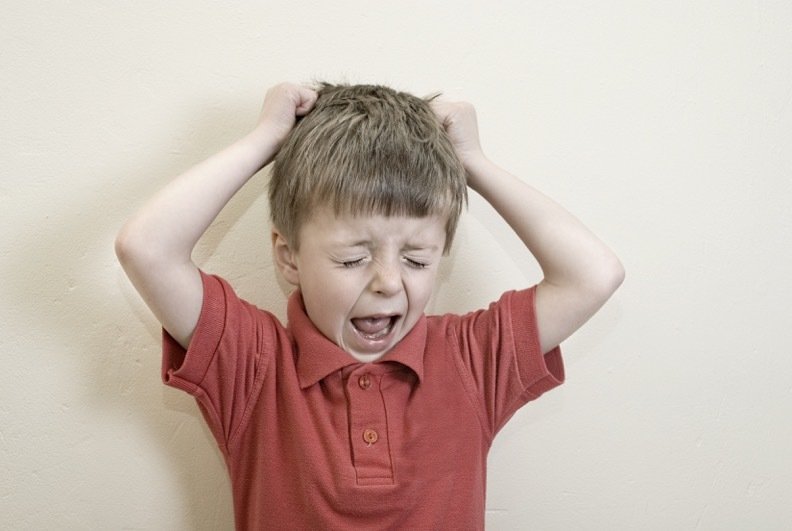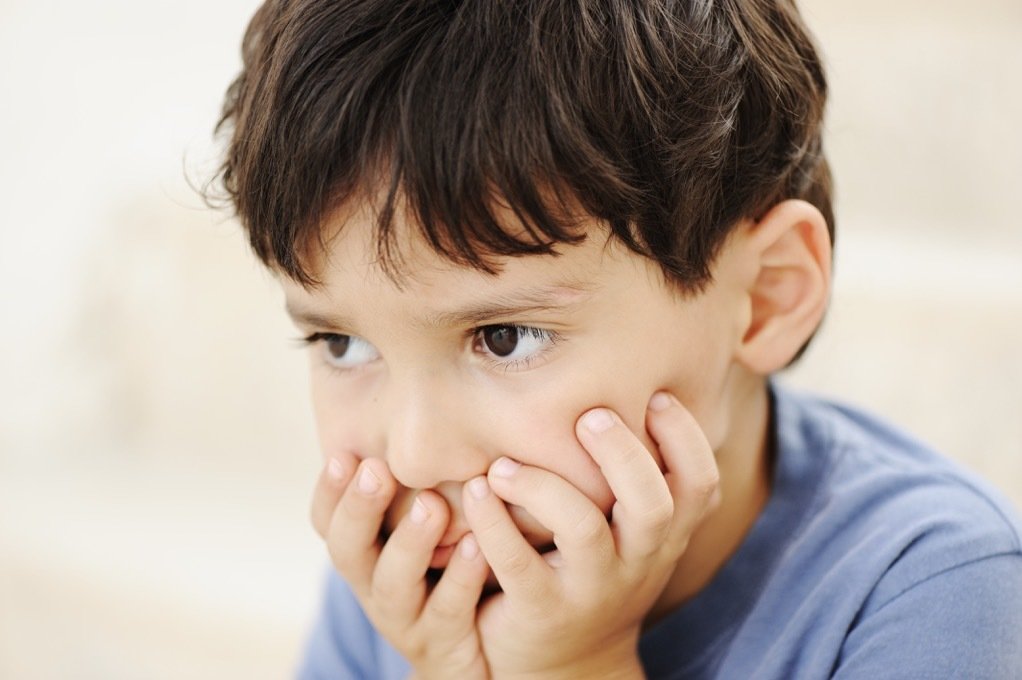Today, 1 in 68 kids are diagnosed with autism — so it's no surprise that many moms are eager to learn more about this condition. And compiled an A to Z guide to autism, which covers the basics as well as the latest research and beyond.
Whether you're curious to learn more about autism symptoms or treatments that help, this guide will lay out this info in jargon-free bite-size components. Consider it a crash course on autism that will get you up to speed in no time.

Have you tried L yet with your kids?
Images via Thinglass/shutterstock; © iStock.com/Anthony Rosenberg
A is for Asperger Syndrome

Asperger Syndrome is one diagnosis on the autism spectrum. These kids typically lack learning disabilities and are of average intelligence or above average intelligence — even geniuses. They may, however, struggle to connect or communicate with others, and show an intense interest in certain activities.
More from The Stir: My Autism Story: Gina's Daughter Has Asperger's
B is for Babbling

One of the earliest symptoms of autism can be picked up starting around 9 to 12 months, when babies start to babble — i.e. go "ba ba ba" or "da da da", precursors to speech. Studies show that children with autism are 17 times less likely to be babbling by this age.
C is for Courtney Love

Think kids with autism can't be party animals? On the contrary, Courtney Love was diagnosed with mild autism at age 9.
D is for Daryl Hannah

Daryl Hannah is diagnosed with Asperger's — and she often worried her career would suffer. "Going to the Academy Awards was so painful for me," she admits. Clearly, though, she's thrived, proving autism doesn't have to hold kids back!
More from The Stir: 5 Kids With Autism Who Inspire All of Us (VIDEO)
E is for Echolalia

One of the most common and unusual signs of autism is echolalia — where kids repeat or "echo" words or phrases they've heard seconds, weeks, or even months beforehand. For instance, a child may utter "Bad Robert! Stop that!" immediately after his mom has said those same words to keep him in line; or he may repeat a famous movie line like, "E.T. phone home" if he's recently watched that movie. The good news? Echolalia isn't necessarily a bad thing; just a different way of processing and learning language.
F is for Functional Play

Kids with autism may not play quite the same as other kids — for instance, they may engage in less "functional play". That's where a child uses an object the way it's meant to be used, like rolling a toy car or using a comb to brush a doll's hair. Kids with autism, on the other hand, may stir a bowl with a brush, or enjoy spinning the wheels of a car without any connection to it being a method of transportation.
G is for Gluten-free

Some research suggests that kids with autism have gluten sensitivities, which has prompted many parents to go gluten-free. And while the scientific research is still divided on whether this dietary intevention helps, anecdotal reports abound of kids who improve, so it could be worth looking into.
H is for Hyper-responsiveness

Many kids with autism tend to overreact (hyper-respond) to sounds or other sensations. For instance, they may scream at the sound of the telephone, or hate the feel of certain clothes like sweaters.
More from The Stir: One Mom’s Passionate Message to Teachers of Kids With Autism
I is for Insistence on Sameness

"Insistence on Sameness" describes how kids with autism tend to prefer activities the same way every time. For instance, they may always line up their toys a certain way, or have a rigid bedtime routine of bath/book/bed. Any changes to these routines may throw them for a loop.
J is for Jenny McCarthy

Jenny McCarthy's son has autism, so she's become a vocal advocate and founder of Generation Rescue, an organization dedicated to helping these kids. While you may not always agree with her opinions, you've gotta admire her dedication to this issue.
K is for KASPAR

Kids with autism often find social interactions with friends and family overly nuanced and unpredictable — which can be frightening and cause them to retreat into their own worlds. Enter KASPAR, a friendly yet "minimally expressive" robot who helps simplify social interactions and make these kids feel comfortable, so they can learn the basics and build from there.
More from The Stir: Severely Abused Puppy Changes Life of Autistic Boy (VIDEO)
L is for LEGO Therapy

Just about all kids love LEGO. Only for kids with autism, these highly structured building blocks can be a beneficial therapy used as motivational tools and to improve interactive play.
M is for Mozart

While no one knows for sure, many experts theorize that Mozart could have been autistic. The evidence: His hearing was very sensitive; loud sounces made him sick. He also had repetitive facial ticks which suggested he had some neurobehavioural disorders. Clearly, though, that didn't hold him back from composing some amazing music.
N is for NDAR

NDAR stands for the National Database for Autism Research, a website run by the National Institutes of Health. It's a wealth of information on NIH-funded autism studies and other data that any parent coping with autism should bookmark and use oten.
O is for OCD

Obsessive compulsive disorder, or OCD, often occurs with autism, and these two conditions also share a lot of the same symptoms — such as repetitive behaviors like hand washing.
P is for PDD-NOS

PDD-NOS stands for pervasive development disorder, not otherwise specified … but if a doctor spouts this off don't feel daunted; it's just another much longer way to describe autism or autism spectrum disorders (ASD). The terms PDD and ASD can be used interchangeably.
More from The Stir: What It's Like to Raise a Kid With Autism — When You're Autistic Too
Q is for… Questions

Many parents may question whether their child has autism, and while many factors should be considered, here are a few common red flags: Your child does not respond to his name at 12 months; does not play pretend games by 18 months; unual reactions to how things sound, smell, or taste. If you spot these signs as well as others, it could be time to consult a professional, since the sooner a child is diagnosed with autism the better.
More from The Stir: Autism Signs to Watch For in Kids
R is for Receptive Language

"Receptive language" is the ability to understand what others are saying — which is something kids with autism often struggle with. By 12 months, kids may respond to their name; by 18 to 20 months they may be able to point to objects when you ask for them ("Where's the wheel on this truck?"). If your child seems slow to demonstrate this skill it could be a red flag if combined with other autism symptoms.
S is for Stimming

One common quirk of autistic kids is "stimming" — self-stimulating movements like rocking, finger twisting or hand wringing. While potentially awkward in public, stimming is not harmful; it's actually a way these kids self-sooth and remain calm.
T is for Temple Grandin

Temple Grandin may have autism, but that didn't stop her from becoming a noted animal research and professor at Colorado State University. Her biography was made into a move starring Claire Danes. Her inspiring message: "The thing about being autistic is that you gradually get less and less autistic, because you keep learning, you keep learning how to behave. It's like being in a play; I'm always in a play."
U is for Under-reactivity

Some kids with autism, rather than over-react to sounds and other stimuluses, do the opposite: they underreact, also called hypo-responsiveness. So, they may not respond to their name, or feel the urge to urinate (which can make potty training a challenge).
More from The Stir: 6 Tips For Potty Training Kids With Autism
V is for Vaccines

For decades, research has studied whether there's a link between autism and vaccines, and the results are overwhelmingly that the answer is no: delaying or skipping vaccines has no impact on autism. Nonetheless, a small faction of anti-vaxxers still believe in abstaining from immunizations, which puts kids at large at risk for potentially fatal diseases.
More from The Stir: Quiz: How Much Do You Really Know About Vaccines?
W is for Words

Some kids with autism struggle to speak or don't at all; it was long believed if they weren't verbal by 4 or 5 they'd likely remain that way. But new research by the Scientists at the Center for Autism and Related Disorders in Balitmore suggests otherwise: Of the 535 autistic children they studied who could use only single words or phrases without verbs by age 4, 47 percent went on to become fluent speakers.
More from The Stir: 10 Best Blogs From Parents of Autistic Children
X is for Fragile X

While the exact cause of autism spectrum disorders remains unknown, researchers have identified possible genetic components. For instance, fragile X syndrome (FXS) causes many of the same learning disabilities in children as autism.
Y is for Yoga

Turns out yoga isn't just a way for Mom to de-stress; research even shows that yoga can help kids with autism behave better. In the study, autistic kids who had a daily yoga program were less aggressive and more social.
Z is for Zoloft

Selective serotonin reuptake inhibitors (SSRIs) may not merely help alleviate depression in the general public; certain ones like Zoloft has been found effective for autism symptoms such as obsessive compulsive behavior. So be sure to explore all your treatment options with your doctor.
More from The Stir: 50 Best Autism Resources Online




